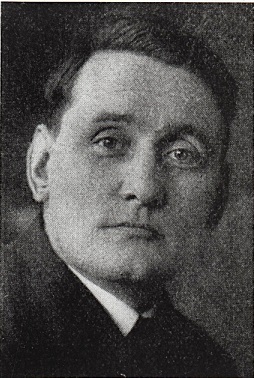Willem Arondéus (1894-1943)

The visual artist and writer Willem Arondéus led the resistance group that carried out an attack on the Amsterdam population registry on March 27, 1943. The raid was successful, but it ended badly for the participants. Arondéus was the first to be arrested and, along with eleven comrades, was executed in the dunes of Overveen on July 1, 1943.
Arondéus had joined the resistance shortly after the outbreak of the war, initially as an individual. In his illegal Brandarisbrief, he urged his fellow artists not to sign up for the Dutch Cultural Chamber and criticized those who did. In 1942, he joined the artists’ resistance and Gerrit van der Veen’s Personal Identification Card Central. Arondéus forged identity cards and ensured that the forgeries reached their intended recipients. He continued his Brandarisbrief in the resistance newspaper De Vrije Kunstenaar.
Within the artists’ resistance, a plan emerged to set fire to the population registry of Amsterdam. It was discovered that the Germans were randomly comparing the forgeries with the data on the identity cards in the registry. These cards needed to be destroyed to conceal the registrations of Jews and men eligible for forced labor. The attack on the Amsterdam population registry was a significant boost for the resistance, leading to more arson attacks in other cities. It is still commemorated in Amsterdam every year.
The biography seeks to answer why Arondéus turned to acts of resistance. As the youngest in a large Amsterdam middle-class family where making money was considered a primary virtue, Arondéus didn’t fit in. He chose art over trade. Encouraged by his art teacher at school but against his father’s wishes, Arondéus pursued training as a decorative painter at the Quellinus School of Applied Arts in Amsterdam. This defiance intensified when, at a young age, he openly acknowledged his homosexuality, leading his father to evict him from the house.
As a visual artist, Arondéus led a life of ups and downs. After meeting Richard Roland Holst, who took the boy under his wing, Arondéus developed into a monumental-decorative artist. Although Roland Holst assisted him with some major commissions - he held influential positions in numerous committees as a respected artist - Arondéus’ aversion to his mentor’s interference outweighed his calling as an artist. He ended his painting career, severed all ties with Roland Holst, and distanced himself from monumental painting in his writings.
In the decades following the war, Arondéus remained in the shadow of Gerrit van der Veen for a long time. Van der Veen’s acts of resistance were widely celebrated, as was his role in the attack on the population registry, where he served as Arondéus’ subordinate as a lieutenant to Captain Arondéus. The roles were reversed. Within the homosexual community, Arondéus is considered an icon of the national resistance. Arondéus was said to have been posthumously denied the Resistance Cross because he was homosexual. This would have tarnished the resistance’s reputation. His homosexuality was even said to have been a significant motivator for his resistance activities. He wanted to show that homosexuals are no less brave than anyone else. His death by a German firing squad was a symbolic sacrifice, in the hope that homosexuality would be accepted rather than despised after the war.
The existing biographies of Arondéus uniformly focus on the assertion that his homosexuality motivated him to join the artists’ resistance and that he wanted to convey this. Without questioning his sexual orientation, the biography will provide a nuanced perspective on Arondéus’ reputation as a resistance fighter. In his authoritative article ‘Biography as corrective’, British-American biographer Nigel Hamilton explained how a biography can alter a reputation. This involves rethinking and re-exploring a life and making corrections to ‘the way we, in current times, see certain historical figures’. This pertains not only to the individual as a personality but also to the historical context and ‘the subject’s historical importance in our understanding of the past, and even the present’. By using previously unexplored sources, personal notes, and other ego documents, the existing image of Arondéus will be stripped of its ‘mythical proportions’, and his courageous actions in the resistance will be ‘disentangled’ from the alleged homosexual motivations that purportedly drove him.
This research contributes to the historiography of World War II and the theme of homosexuality in relation to the history of occupation and resistance in the Netherlands. Furthermore, this research significantly expands the limited existing knowledge about the visual artist, writer Willem Arondéus, and his Nachleben. Arondéus’ most significant act of resistance, the attack on the Amsterdam population registry, will be reconstructed anew, largely based on previously unexamined material. In this way, Willem Arondéus’ participant perspective on a crucial event during World War II, about which so much has already been written, will be compared to the story told thus far.
This doctoral research is supervised by Prof. Dr. J.W. (Hans) Renders and Prof. Dr. D.F.J. (Doeko) Bosscher.
Marco Entrop is a Dutch scholar, freelance writer, and researcher. He is a co-founder and editor of the literary-historical journal De Parelduiker and writes about art, literary, and theater-historical subjects. In 1993, he published Onbekwaam in het compromis (‘Unable to compromise’), a biographical sketch of the artist and resistance fighter Willem Arondéus. He contributed to Willem & Frieda (2023), a documentary by Channel 4 about Willem Arondéus and Frida Belinfante.
e-mail: marco.entrop gmail.com
